A Budget Home Theater & PC Setup: 4K, HDR, UHD Blu-ray, and More
by Ganesh T S on December 26, 2017 8:30 AM ESTLocal Media Playback
Our typical HTPC testing flow involves playing back files encompassing a range of relevant codecs, containers, resolutions, and frame rates. A note of the efficiency is also made by tracking GPU usage and power consumption of the system at the wall. Over the last year or two, the focus has been on using Kodi and MPC-HC with its built-in LAV filters for benchmarking. Even though we have had non-HDR 4K clips for some time now in our test suite, we have not subject them playback at native resolution. In order to augment our test suite, we have added two files, a 4Kp25 HEVC HDR stream in a MKV container, and a 4Kp60 VP9 Profile 2 HDR stream in a WebM container.
Out of all the options we evaluated, the TCL 55P607's in-built Roku platform is the only one capable of handling Dolby Vision videos. However, when we tried to play back a sample file, the Roku interface stalled in the retrieving stage after the appearance of the Dolby Vision logo.
The TCL 55P607 Roku Media Player App - Unable to Handle Local Dolby Vision Files
Due to the absence of reliable open-source editing and decoding tools for Dolby Vision in the PC space, its testing with local media files will have to wait.
The Roku Media Player app continues to be a disappointment for users with anything other than the standard H.264 / HEVC-based camcorder files. The following recorded clip shows its failure with some interlaced MPEG-2 and H.264 clips in TS containers. VC-1 is also not supported.
On the plus side, we have automatic switching to HDR for local files which have HEVC HDR content. On the othr hand, a VP9 Profile 2 HDR clip did not generate the mode switch.
We tracked the power consumption of the TV while the Roku interface tried playing back the various files in our test suite. It was not much of a surprise to find that Roku fails to play back many of the streams. The graph segments below corresponding to the files that didn't play back are just the display remaining idle in the Roku USB Player interface.
The NVIDIA SATV supports all files in our test suite except the one encoded in VP9 Profile 2. With Kodi, we even see the HEVC HDR file being decoded and sent to the display with the appropriate mode switch.
The NVIDIA SHIELD Android TV Supports HDR Playback with Local Files
The power consumption of the SATV was tracked during the playback of each file in our test suite using Kodi 17.6. The segment corresponding to the VP9 Profile 2 file is just the duration for which the audio track was decoded and the Kodi UI remained idle.
Moving on to the PC space, we first compare the DXVAChecker outputs for the three systems. The Zotac EN1080K with its GTX 1080 GPU does not support hardware decoding of VP9 Profile 2 videos. Even if a HDR stream were to be available, the system plays back only the non-HDR versions with the desktop in HDR mode.
The Absence of VP9 10-bit Profile 2 Decoding in the GTX 1080 is the Only Odd Spot (from L to R: ASRock Beebox-S 7200U, Zotac ZBOX MAGNUS EN1080K, and the Intel NUC7i7BNHX1)
We found the native Microsoft Movies & TV app to be capable of playing back HDR videos with the desktop in HDR mode. A comparison of playback using two different players in that mode is shown below.
However, the playback of HDR files in non-HDR mode using the Microsoft Movies & TV App results in messed up colors. As such, we don't recommend the Movies & TV app for HDR file playback under all circumstances.
It is possible to use the madVR renderer in conjunction with a suitable player to shift the display to HDR mode independent of the OS setting. It is also supposed to bring the display back to the original state when exiting. We tested it out with MPC-HC and madVR v0.92.10 on the Zotac EN1080K. On the KBL-U systems, using madVR as the renderer resulted in evident dropped frames irrespective of the setting. On the Zotac EN1080K, we found that the latest NVIDIA driver release (which we absolutely had to use for Netflix 4K playback) seemed to have some issues with the restoration of the previous mode. With certain settings, the colors seemed to get crushed significantly after madVR triggered the mode change.
In fact, the only reliable combination in which we could get playback of the files in the appropriate mode was to set the OS toggle for HDR, and allow madVR to pass through the HDR metadata directly to the display (something that the madVR author specifically mentions as unsuitable for purists). We do not have automatic mode switching or even identification of HDR when using Kodi (as of v17.6). With madVR and MPC-HC, it is possible, but the consumer experience may vary.
In our opinion, HDR local media playback is yet to reach a stable state with commonly used software combinations. CyberLink's PowerDVD 17 also supports automatic HDR mode switch for playback of local files on Intel GPU-based systems. We found that it worked well in both of the KBL-U PCs, but, PowerDVD unfortunately refused to play back the VP9 Profile 2 files on those systems.
The power consumption of the three PCs during the playback of each file in our test suite using Kodi 17.6 was recorded. The same was done using the Microsoft Movies & TV app also, but, we found significant power consumption change (up to 10W at the wall) when the control overlay appeared on the screen. As such, we believe that the Microsoft Movies & TV app is not a reliable way to determine media processing efficiency of any system.
A similar graph for the madVR playback case in the Zotac ZBOX EN1080K (with OS HDR toggle set and madVR configured for HDR passthrough in full screen windowed mode) is presented below.
The power consumption numbers were also graphed for the PowerDVD playback case using the two KBL-U systems.
In general, we find that the Zotac system consumes a lot of power, but, it also performs a lot better compared to the KBL-U systems when advanced HTPC requirements like madVR rendering are considered. The HDR ecosystem is just getting started and we are waiting for things to reach a more matured state before doing a detailed analysis of the playback of local HDR files in PCs.


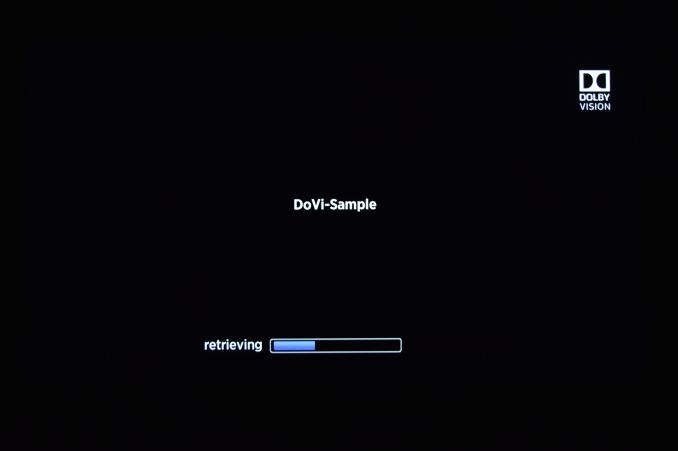

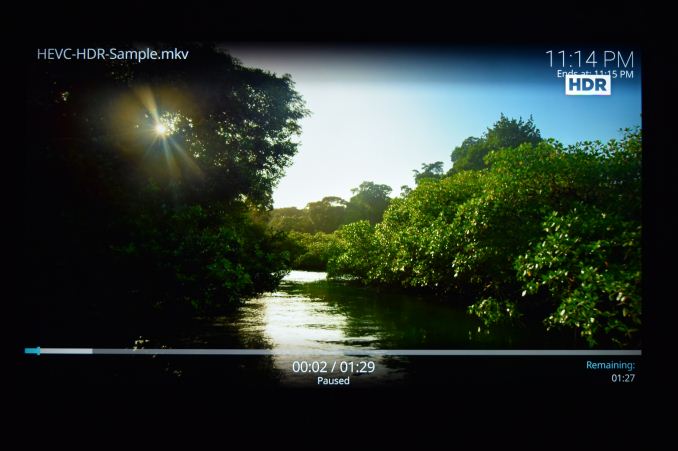
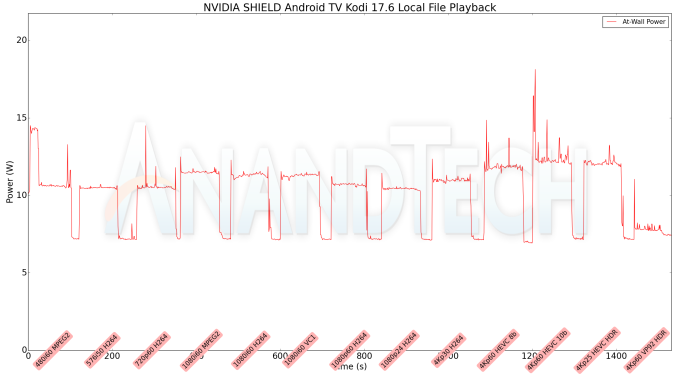
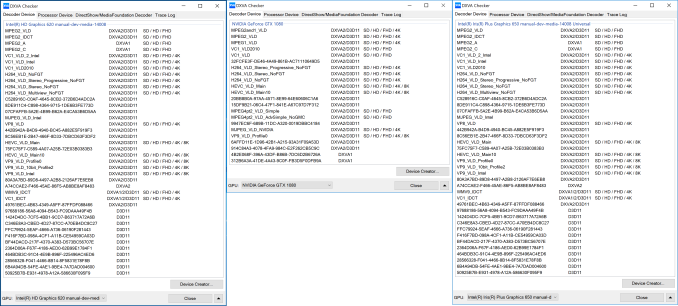
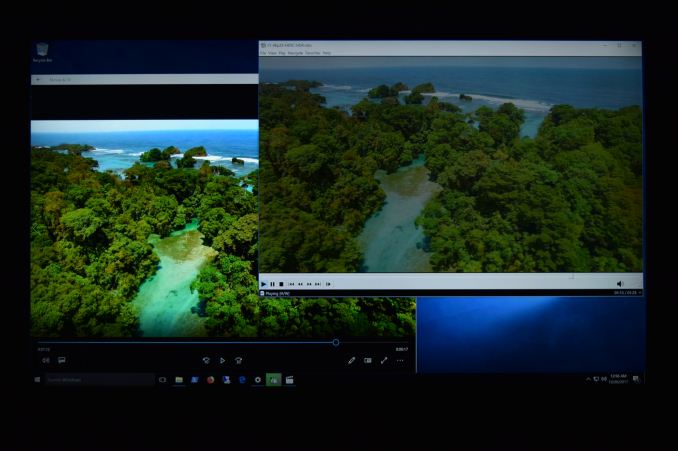
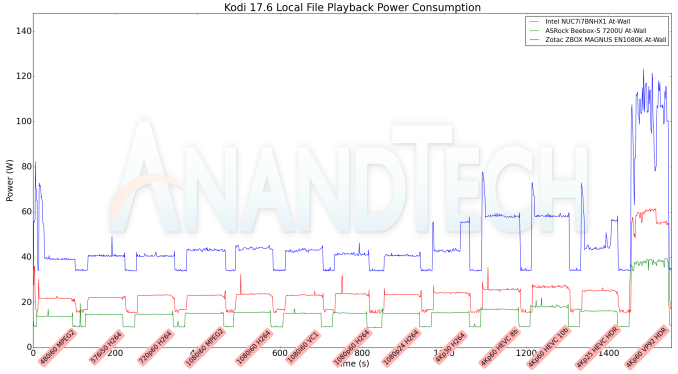










191 Comments
View All Comments
ddrіver - Wednesday, December 27, 2017 - link
If you have enough time reading them then I consider I'm doing a public service ;).Notmyusualid - Tuesday, December 26, 2017 - link
@ganeshtsTry to ignore ddriver - he could have an argument in an empty room.
ddrіver - Wednesday, December 27, 2017 - link
As long as it's a good argument? Why share a piece of crap with people when I can have a cake all by myself?Notmyusualid - Thursday, December 28, 2017 - link
@ ddriverEVERY possible argument seems to be a 'good one' for you.
Here, I think these people can help you:
https://en.wikipedia.org/wiki/Dignitas_(Swiss_non-...
Duckeenie - Wednesday, December 27, 2017 - link
Dude, seriously? Oxymoron?Crazyeyeskillah - Thursday, December 28, 2017 - link
There is nothing budget about this review. You are painfully out of touch with your readership. I've been on this website since 2001 and honestly don't know why I bother reading anything that isn't written by Ryan at this point. Really a shame what is left for Anands legacy.lmcd - Tuesday, December 26, 2017 - link
Given that the primary point of the article was the HTPC itself, there's literally no point in your comment except to continue your pattern of abuse. This is equivalent to talking about "storage on a budget" and using an expensive CPU to test the storage solution.ddrіver - Wednesday, December 27, 2017 - link
@lmcd: For your sake I hope you're pretty because you sure don't score any points on the IQ scale.The article is LITERALLY about "A Budget Home Theater & PC Setup". Not just "the HTPC itself". Reading comprehension fail. The article LITERALLY describes both. And although you may assume home theater is a wooden podium with really tiny actors putting on a play for you, it's actually not. A receiver is an integral part of a home theater. This is why the receiver is on the 3rd page of the article, before "the HTPC itself".
Which brings us to my gripe: a $1000 receiver and a $2000 HTPC recommendation are not budget by any stretch of the definition. Which means the very first part of the title is complete and total BS. Kind of like your understanding of the text... or words in general. Literally.
Reflex - Wednesday, December 27, 2017 - link
As usual reading comprehension is not your strong suite. The article lists two receiver options, one for $999 and one for $430. Nether is top tier nor considered 'expensive' in the receiver space. It offered three HTPC options, two which could be configured for $600-800, and one that was gaming focused for $2000. Again, perfectly reasonable budget options while highlighting the current cream of the HTPC gaming crop as an option for those with the budget.If I have a complaint about this article its that I'd have liked for them to offer one or two steps up on each category, for instance I chose to focus on the display for my setup and dropped $2k on a 65" OLED and then went cheap on the HTPC by using a XB1S.
None of the recommendations listed would be considered expensive, or even mid-range for the home theater space. Not even the $2k HTPC, honestly although it was the closest item. Mid-range in this space starts at around $20k, and goes up to around $200k before you get to the actual crazy setups (real home theaters).
But again, reading comprehension is not your strength, nor is knowledge of the areas in which you spout word salad like something sold by RonCo.
ddrіver - Thursday, December 28, 2017 - link
Oh Reflex, if only you paid more attention to making sense instead of just hurling whatever you pull out of your a$$.The fact that the author mentions another option once and then never describes anything related to it again is useless. If "mentioning" something was enough this article could very well have been a short table with the components needed. Basically the table on the last page (but one that actually lists the cheap AVR option).
Secondly, reviewing a "budget" setup where the actual receiver used is $1000 redefines the meaning of "budget". The $2000 HTPC must be a stupid joke only the author gets. Google for "budget receivers" and tell me what the ENTIRE INTERNET believes "budget" means. But I'm sure you're smarter than everyone else... in your own tiny head.
Only a bumbling moron can think these prices are "budget" because "midrange starts at $20000". And yeah, you refuse to actually read any of the comments that make good points here and prefer to focus on your own understanding of what I wrote, on rants about $20k midrange setups, and other stuff only you could think is reasonable. So you definitely fit that description.
But but but wait. $200k is actually entry level pocket change, far from a "crazy setup" you seem to think it is. Compared to real home theater systems:
https://www.theaterseatstore.com/most-expensive-ho...
https://www.octaneseating.com/most-expensive-home-...
But I need a good laugh. Keep going with your "knowledge". ;)